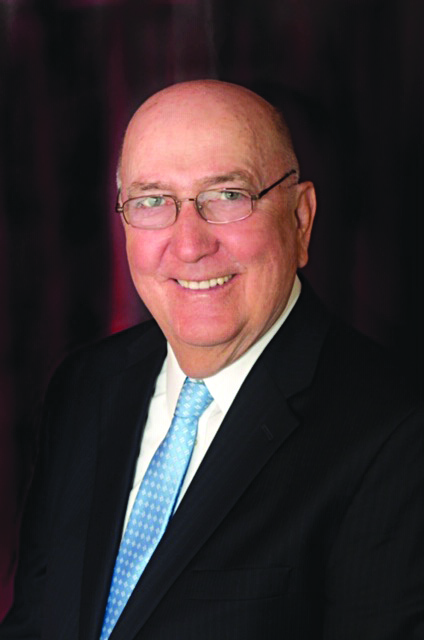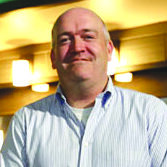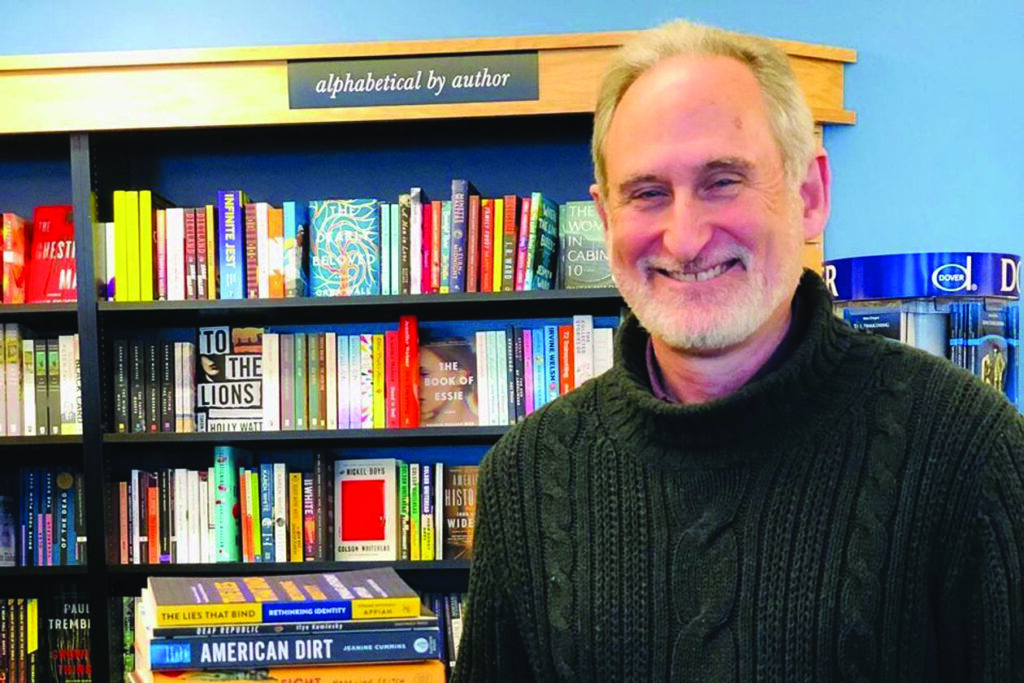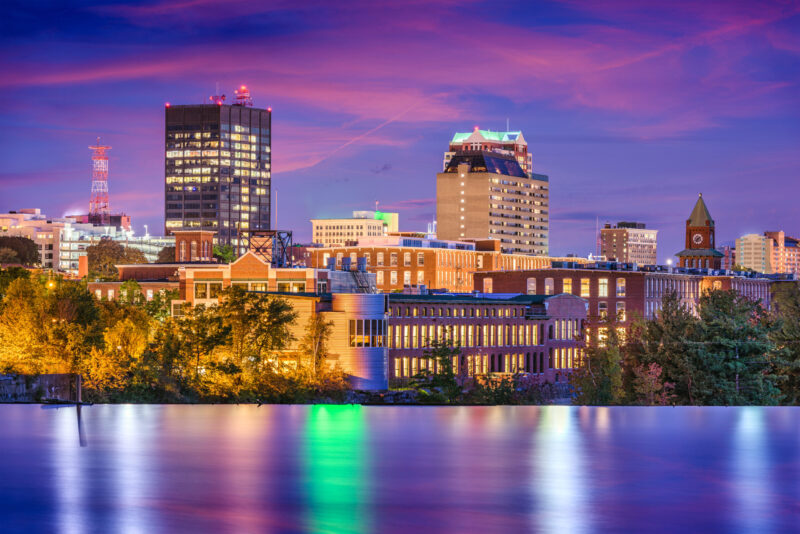Two decades of revitalization in Manchester, Concord and Nashua’s downtowns
When the Hippo started in 2001 with the intention of highlighting Manchester’s culture, well, there wasn’t nearly as much going on then as there is now (or was, pre-pandemic, and will be again, soon…). In the first of a month-long series looking back at some of the subjects Hippo has covered over the years, former Mayor Bob Baines, real-estate developer Dick Anagnost and Mint Bistro owner Tim Baines look back at what they call the “renaissance” of downtown Manchester, while Tim Sink of the Concord Chamber of Commerce and Michael Herrmann, owner of Gibson’s Bookstore, talk about how downtown Concord has changed, and Dan O’Donnell of Nashua’s Great American Downtown shares his decades of experience in the Gate City’s downtown.
Bob Baines

Bob Baines was the principal of Manchester West High School for 20 years, then served as mayor of Manchester for six years starting in 2000. He’s worked at Southern New Hampshire University and was president of Chester College for six years, and he continues to do education reform work, most recently with a program called Steam Ahead at West High School and McLaughlin Middle School. He’s been on the board of the Palace Theatre for many years and is on the board of Manchester Public Television, and he recently joined the board of the Community College System of New Hampshire after serving eight years on the board of the University System of New Hampshire.
How would you describe downtown Manchester 20 years ago? What was it like as a destination, as a place to work and as a place to live?
During that time, when I became mayor there wasn’t much going on in Manchester at all. We had suffered through hard times in the ’90s and downtown was practically deserted. … The city was in tough shape, and I was fortunate enough to get the support of the aldermen to do a lot of things with economic development downtown. … When I was mayor there wasn’t even any place to go to lunch in downtown Manchester. … On Elm Street there were a lot of vacant buildings, a lot of rundown buildings, there wasn’t any housing. … Manchester is a totally different city than it was 20 years ago. … The Palace Theatre … had closed and went bankrupt. … Manchester was not a destination — there really was no place to go. There was one restaurant on Lowell Street called Richard’s Bistro, and that was about it.
Bob Baines on the Hippo
I go back to when Hippo Press started … Jody [Reese] and Dan [Szczesny] came to see me about this idea of launching this paper and they said it was going to be called the Hippo. I was sort of puzzled about the name; I remember when they left my office I … called Jody and said, ‘Are you sure you want to call it the Hippo?’
What do you think the most significant changes were over the last 20 years?
The three key kingpins of the economic renaissance of the city were the Palace Theatre [reopening], the Verizon Wireless Arena [now the SNHU Arena]… and the [Fisher Cats] baseball stadium. … [Those three things] really put Manchester on the map. … During that time period there was a lot of excitement about the Manchester public schools [too]. The buildings hadn’t been touched in decades. … There were so many issues. When I was high school principal, I was one of the big complainers … saying we’ve got to spend some money to fix our schools. … At that time they were renovating City Hall and committed to building an arena and I said that’s all well and good that you’re doing that, but our students deserve better, and we got the support of the Board of Mayor and Aldermen to get a $1.5 million bond passed to renovate all the schools in the city of Manchester, so that was a really big deal. Unfortunately as the years have gone on, the proper amount of money has not been invested into teaching and learning and technology and professional development. … I’m very involved in an organization now called Manchester Proud … and we’ve raised over a million dollars to develop a strategic plan for the district, and we’re an active group still raising money to advance education in the city.
What do you think the downtown will be like 20 years from now? What will the biggest challenges be over the next 20 years?
I think good times are ahead despite the quagmire we’re in right now. … I hope [downtown is] still a vibrant part of the city. I think you’re going to get more and more people looking for opportunities to live in the downtown or live in the millyard. … They’re still creating housing units in the millyard. I think downtown still has a lot of possibilities for other development … to provide the kind of housing that people are looking for, especially young people. … Young people who work in all these tech companies, a lot of them want to live downtown because they don’t want cars. … I think the future looks bright in the next 20 years. … I think the biggest challenge is to get people to invest in the city, and I’ve always said you can’t have a great city without a great public education system, and I think that has been the challenge for decades in Manchester. … We should have the very best public schools in the state of New Hampshire. … I hope our city fathers recognize that we have to invest in our schools.
What has been the most surprising thing about the way downtown has developed?
The thing that surprised me when I was mayor was the willingness of local developers to get involved, people who grew up in Manchester, people like Dick Anagnost and [Arthur] Sullivan and his partners. A lot of the great things that happened in Manchester were the catalyst of people who grew up in Manchester and went to schools in Manchester. … It was certainly indicative of the Manchester spirit that people who grew up in Manchester and are now doing well helped revitalize our city, and they continue to do it.
What is your favorite spot to (eventually) hang out in downtown?
[Laughing] Mint Bistro! [Ed note: Mint Bistro is owned by Baines’ son, Tim Baines, who was also interviewed for this story.] … We really miss being able to go there. It’s like not being able to see family. … That’s our favorite place, and hopefully in the not so distant future we’ll be able to go back.

Dick Anagnost
Dick Anagnost was born and raised in Manchester and has been involved in real estate development in Manchester for decades; in the past 20 years alone, he estimates that his company has renovated nearly 40 buildings, put up close to 600 units of housing and created approximately 400,000 square feet of new commercial office space.
How would you describe downtown Manchester 20 years ago? What was it like as a destination, as a place to work and as a place to live?
It was a raceway. Most of the commercial buildings were boarded up and abandoned, there was nobody living there. … The kids used to race up and down the streets and the police were tasked with trying to catch them. Downtown Manchester was pretty well abandoned. … That was about the time that the City decided that they needed to do something to bring back our downtown and millyard. … I received tons of cooperation from the City and actually joint ventured a number of buildings with the City. The first renovation downtown was a building called the Chase Block, where Margarita’s is. … That was actually a joint venture with Anagnost and the City of Manchester.
What do you think the most significant changes were over the last 20 years?
The City and I began moving down the street, so from [the Chase Block] we went to the next corner south, which is 1015 Elm, we went to 844 Elm, we participated with Paul Smith at the corner of Amherst and Elm. I took on parts of south Manchester, so I had Market Basket [brought in]. Murphy’s Tavern was another one of my deals. We started in the millyard with 33 S. Commercial St. … that whole development down there, Southern New Hampshire University is all me. We began marching through the rest of the city together and at about the same time Brady Sullivan started to see our success, and they started with the old gas company building and then they did a number of buildings downtown. … They have a huge stake in the renovation and renaissance of downtown as well. It all started with the Chase Block, and about parallel with the Chase Block was the Verizon civic center decision. The civic center was a key player, the construction of the ballpark, the southern side of the millyard was a key construction project.
Dick Anagnost on the Hippo
Every time I needed help persuading the aldermen to do something, Jody and the guys, you know, Jeff [Rapsis] … and Dan [Szczesny], all jumped in and wrote things to get support and public opinion on my side. I have a long relationship with them; I was there when they went into business. … You could actually attribute the Hippo to a lot of Manchester downtown’s growth. They were the ones writing about the opening of Margarita’s and the opening of this restaurant and the Palace Theatre renovations and all those things. They were pointing out all of the good things that were going on in Manchester. … They were a break from reality. … They thought outside the box. … They brought forth the whole concept of, these are the things that are going on, these are the things you can do, that helped downtown particularly go through its renaissance. … You asked a question, what were the most significant changes? One of them was HippoPress.
What has been the most surprising thing about the way downtown has developed?
The upper stories are still underutilized. When I was growing up the upper stories were filled with offices and residential tenants and all kinds of things, so the buildings were all full. We still have not addressed the issue of trying to make buildings from the 1800s meet the codes of this millennium, and until that happens the upper stories will remain sparsely occupied. I mean, I was able in my buildings to renovate the upper stories by coming up with innovative methods to coordinate and … find different solutions to [meet] the codes. For instance, when we did Paul Smith’s building at Amherst Street, which [probably had] the best, most preserved original historic finishes from the 1800s, we … came up with a way to … [make] what was essentially a sprinkler system that created a safe corridor for people to get out of without having to tear out all of the historical things. At 1015 Elm St., which is where Baked is, we creatively put retail on the first floor, office on the second floor, residential units above it, but there was a fire egress issue … they allowed us to put a double-wide staircase in the rear and keep the smaller historic granite and marble staircase in the front. … It’s cost-prohibitive to renovate the upper floors, but we’re in such dire housing need, the upper floors of downtown would be the perfect opportunity to put in workforce type housing. We’ve now grown into a college town … and they’re always in a deficit for student housing. We could easily turn the upper floors … into student housing and workforce housing. That would be the key in my opinion to bringing back downtown 100 percent to its most vibrant point, because those people wouldn’t need vehicles, but … because downtown is such a walkable area, they would be able to service and support all the businesses located in downtown. Which is how downtown used to be in the ’60s and ’70s when I grew up.
What do you think the downtown will be like 20 years from now? What will the biggest challenges be over the next 20 years?
I think it’ll look a lot like it is now. You still have the traffic generators. When I started working in the millyard, it was 5 million feet with 90 percent vacancy and 10 percent occupancy. Your millyard today is probably 4.8 million feet and it’s 93 percent occupied, so the millyard is a significant generator. The Verizon is a significant traffic generator. The ballpark is a significant traffic generator. All of the new housing that’s coming in downtown, like the ones that are at the ballpark. The one finishing touch would be to [bring] the upper stories … back to their usefulness, to making them mostly residential. … There’s a huge demand. Vacancy in the city is about 1 percent. That would be an easy place to put a whole lot of housing. … [The biggest challenge will be] the codes. … In order to be code compliant, you need to spend too much money, more than [the] economic value of the property.
What is your favorite spot to (eventually) hang out in downtown?
My office, because I have to come here every day and I spend a significant amount of time here, so we’ve made it comfortable enough for us to hang out in for long periods of time. … I’ve always kind of put my money where my mouth is, so I was one of the first people to move my main offices, first into the millyard when we were redoing the millyard, and then into downtown when were redoing downtown, and this [1662 Elm St.] is one of the buildings I renovated.
Tim Baines

Tim Baines was born and raised in Manchester and is the owner of Mint Bistro on Elm Street, and he announced on Dec. 21 that he and two business partners will be opening Elm House of Pizza in January at 102 Elm St. Baines also served as alderman for Ward 3 for one term.
How would you describe downtown Manchester 20 years ago? What was it like as a destination, as a place to work and as a place to live?
Downtown Manchester 20 years ago was in a tough place (much of it abandoned) but there was hope on the horizon. The civic center, as it was referred to at the time, was a hotly contested issue in 1999 and 2000. It ultimately prevailed and was a part of a renaissance of sorts. There was probably one fine dining establishment and a few bars. There [were] a few solid anchor retail stores that brought people to the downtown on weekends, but it certainly was not a destination for most. Very few people were looking to live … downtown at this time.
What do you think the most significant changes were over the last 20 years?
Over the past 20 years there has been strong leadership that has realized what a thriving downtown can do for a city, the tax base and the quality of life. Whether it was ensuring that the Palace Theatre stayed alive through tough times or [because of] investments [that were supported by] the government but executed by the private sector, Manchester’s downtown grew and became a place that people wanted to be a part of. The condition of a downtown can truly make or break a city and we have had leadership over these 20 years that [has] fostered this and understood this. With good governance comes private citizens and investors believing in it, and we have seen amazing investments in our downtown.
What do you think the downtown will be like 20 years from now? What will the biggest challenges be over the next 20 years?
I believe in my heart that leaders in this community will step up and make sure that all of our progress continues. I hope it’s more walkable, I hope that businesses can control their sidewalks and I hope that we have more retail. It truly will come down to leadership and I am hopeful there are enough people out there that know that bringing people together is the way to make many of these things happen. Smart, common-sense and decisive leadership will go a long way. The biggest challenge will be how we handle the issues of the day that are squarely in front of us. No successful or thriving city has all of the resources available for those suffering in the downtown. We have an obligation to help people and we need to, but attracting those suffering to an area with the temptations that our downtown has to offer continues to send us down the wrong path. A facility away from the downtown that offers services, counseling, detox [and] hope, and one that is well-funded, will go a long way. This will take political courage.
What has been the most surprising thing about the way downtown has developed?
It’s a community. With a few glaring exceptions everyone cheers for each other and knows that the others’ success is part of their own success. It’s a beautiful thing. As far as surprising, I would have to say the lack of understanding by government officials as to what it takes to survive in the private sector. It has been discouraging to see leadership not understand the fundamentals of how A affects B and affects C. It has demoralized people.
What is your favorite spot to (eventually) hang out in downtown?
[They don’t exist yet, but I would like to see] a few things: a movie theater, a beer garden and a community event that rivals what Riverfest used to be.
Michael Herrmann

Michael Herrmann has been the owner of Gibson’s Bookstore in Concord since 1994, and he has served on the boards of Intown Concord and the Chamber of Commerce.
How would you describe downtown Concord 20 years ago? What was it like as a destination, as a place to work and as a place to live?
Concord has always been blessed to have a thriving downtown, and even 20 years ago it was an attractive place to visit, with many interesting shops. It was starting to look tired, but there was a real community of shop owners and regular visitors, and it was fun to be part of it.
What do you think the most significant changes were over the last 20 years?
For the downtown, certainly the Main Street redevelopment of 2016, and also the expansion of the downtown south of Pleasant Street.
What do you think the downtown will be like 20 years from now? What will the biggest challenges be over the next 20 years?
The rise of internet commerce has put all retail at risk, but I believe that people will continue to want to shop local and support institutions that make our city unique. The biggest challenge for downtown is to have businesses that are sufficiently capitalized so they can weather crises like the one we’ve seen this year.
What has been the most surprising thing about the way downtown has developed?
So many banks — some of my best friends are bankers, but these locations are like dead zones. The ground-floor spots on Main Street should be devoted to retail.
What is your favorite spot to (eventually) hang out in downtown?
I can’t wait to spend too much money at all the restaurants downtown. For now, I’ll just be buying gift cards and doing takeout.

Tim Sink
Tim Sink has been the president and CEO of the Greater Concord Chamber of Commerce since 1992; for the last 10 years he’s worked at its office on Main Street. He’s lived in Concord for about 35 years and raised his family there.
How would you describe downtown Concord 20 years ago? What was it like as a destination, as a place to work and as a place to live?
Twenty years ago downtown Concord was in the beginning of a renaissance. Capitol Center for the Arts had just opened, Capital Commons was going up with a much needed parking garage and downtown festivals like Market Days were growing more vibrant. The downtown was starting to wake up.
What do you think the most significant changes were over the last 20 years?
The redevelopment and redesign of Main Street, Red River Theatres, Capitol Center for the Arts, Bank of New Hampshire Stage, expansion and relocation of the League of New Hampshire Craftsmen and Gibson’s Bookstore, more public art and greater cultural diversity have all contributed to a much more vibrant, destination downtown.
What do you think the downtown will be like 20 years from now? What will the biggest challenges be over the next 20 years?
The boundaries of what we now consider downtown Concord will expand east [and] west and further south. The main gateway at Exit 14 will be vastly improved.
What has been the most surprising thing about the way downtown has developed?
The creativity and resilience of the retail, hospitality and dining sectors.
What is your favorite spot to (eventually) hang out in downtown?
Bicentennial Square

Dan O’Donnell
Dan O’Donnell is the president of the Executive Board for Nashua’s Great American Downtown. He was born and raised in Nashua, spent 40 years as an educator in the Nashua School District before retiring in 2015, and is now a Realtor with Keller Williams Gateway Realty in Nashua. He has been a member of numerous organizations in Nashua, such as the Jaycees, Masons and Lions Club. Though he now physically resides in Hollis, he continues to tell people he “lives” in Nashua and always will.
How would you describe downtown Nashua 20 years ago? What was it like as a destination, as a place to work and as a place to live?
Nashua’s downtown has always been a great place to dine and shop. Back in the ’80s as more and more box stores and big malls opened on the outskirts of Nashua, people drifted away to experience that newfound convenience shopping, but it always lacked the character, charm and personal service that downtown offered. Since then the City of Nashua, Downtown Merchants Association, Great American Downtown and numerous volunteers have spent enormous amounts of time, energy and capital in revisioning, revitalizing and recreating what I would call the rebirth of downtown Nashua. Today’s downtown Nashua is a much more warm and inviting environment. It is once again the heart of the city and a special gathering place for residents and visitors … [and] has the highest-quality restaurants, unique and specialized shopping venues, art galleries, live music venues and an upcoming Performing Arts Center.
What do you think the most significant changes were over the last 20 years?
I believe that the most significant change is that people realized the most important part of any community is its people. We live in an unbelievably fast paced, instant gratification world. Malls and box stores are sterile environments and have no socially redeeming benefits. Downtowns provide far more social interactions, give us personalized service, which we have been missing, and they provide a connection with our friends and community.
What do you think the downtown will be like 20 years from now? What will the biggest challenges be over the next 20 years?
We are currently in a new phase in Nashua where we are experiencing significant growth in inner city housing starts. As this continues we will see further growth and opportunities in downtown Nashua.
What has been the most surprising thing about the way downtown has developed?
The most surprising thing about the development of downtown Nashua has been the pace of the growth and outstanding support from the community at large.
What is your favorite spot to (eventually) hang out in downtown?
My favorite future spot will be the new Performing Arts Center as it is a long overdue need for our community. I think it will be a huge draw in the further rebirth and revitalization of our Great American Downtown.
This story was possible with the generous financial support of Hippo readers. Hippo is very grateful to have the support of its readers. If you haven’t contributed yet, please consider a small contribution. Your contributions allow Hippo to write more stories and gets you access to additional stories and columns.

